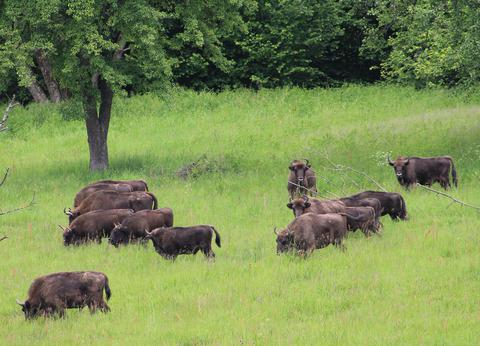当前位置:
X-MOL 学术
›
Anim. Conserv.
›
论文详情
Our official English website, www.x-mol.net, welcomes your feedback! (Note: you will need to create a separate account there.)
Connectivity or isolation? Identifying reintroduction sites for multiple conservation objectives for wisents in Poland
Animal Conservation ( IF 3.4 ) Pub Date : 2019-08-06 , DOI: 10.1111/acv.12530 K. Perzanowski 1 , B. Bleyhl 2 , W. Olech 3 , T. Kuemmerle 2, 4
Animal Conservation ( IF 3.4 ) Pub Date : 2019-08-06 , DOI: 10.1111/acv.12530 K. Perzanowski 1 , B. Bleyhl 2 , W. Olech 3 , T. Kuemmerle 2, 4
Affiliation

|
Large herbivores and carnivores today often only occupy small fractions of their former ranges, and restoring them is a conservation priority. Reintroductions may serve two critical goals in this context: (1) to expand and connect existing populations, or (2) to increase the number of separate populations as insurance in case individual populations are lost, for example, to disease. We developed an approach to identify reintroduction sites for both purposes, using an applied example of European bison or wisent (Bison bonasus) in Poland. Using a large occurrence dataset from all extant herds in Poland, we mapped suitable wisent habitats throughout Poland using a species distribution modelling approach. We identified 47 patches of suitable habitat, together covering 20,710 km², and used graph theory tools to identify the top candidate reintroduction sites for (1) connecting existing herds into larger metapopulations or (2) establishing ‘reservoir’ herds that could serve as a backup in case of mass die‐offs. The most well‐connected habitat patches ranged between 203 and 728 km² and occurred mainly in north‐western and south‐eastern Poland, in close vicinity to other free‐ranging herds. In contrast, candidate sites for reservoir herds were smaller (204–410 km²) and occurred mainly in central Poland. Our approach provides a possible blueprint for wisent reintroductions in Poland. More broadly, our work also highlights how jointly planning for multiple conservation goals for wide‐ranging species that depend on reintroductions or translocations can be achieved at the regional scale.
中文翻译:

连通性还是隔离性?为波兰明智的多重保护目标确定重新引入地点
今天的大型食草动物和食肉动物通常只占据它们以前范围的一小部分,恢复它们是保护的优先事项。在这种情况下,重新引入可能有两个关键目标:(1) 扩大和连接现有种群,或 (2) 增加单独种群的数量,以防止个别种群因疾病而丧失。我们使用波兰的欧洲野牛或智者(Bison Bonasus)的应用示例,开发了一种方法来为这两种目的确定重新引入地点。使用来自波兰所有现存畜群的大型发生数据集,我们使用物种分布建模方法绘制了整个波兰合适的智慧栖息地。我们确定了 47 块合适的栖息地,共覆盖 20,710 平方公里,并使用图论工具确定最佳候选重新引入地点,以 (1) 将现有畜群连接到更大的复合种群或 (2) 建立“储备”畜群,在大规模死亡的情况下可以作为备份。连接最紧密的栖息地斑块面积在 203 到 728 平方公里之间,主要发生在波兰西北部和东南部,靠近其他自由放养的畜群。相比之下,水库群的候选地点较小(204-410 平方公里),主要发生在波兰中部。我们的方法为在波兰明智地重新引入提供了一个可能的蓝图。更广泛地说,我们的工作还强调了如何在区域范围内为依赖重新引入或易地的广泛物种共同规划多个保护目标。
更新日期:2019-08-06
中文翻译:

连通性还是隔离性?为波兰明智的多重保护目标确定重新引入地点
今天的大型食草动物和食肉动物通常只占据它们以前范围的一小部分,恢复它们是保护的优先事项。在这种情况下,重新引入可能有两个关键目标:(1) 扩大和连接现有种群,或 (2) 增加单独种群的数量,以防止个别种群因疾病而丧失。我们使用波兰的欧洲野牛或智者(Bison Bonasus)的应用示例,开发了一种方法来为这两种目的确定重新引入地点。使用来自波兰所有现存畜群的大型发生数据集,我们使用物种分布建模方法绘制了整个波兰合适的智慧栖息地。我们确定了 47 块合适的栖息地,共覆盖 20,710 平方公里,并使用图论工具确定最佳候选重新引入地点,以 (1) 将现有畜群连接到更大的复合种群或 (2) 建立“储备”畜群,在大规模死亡的情况下可以作为备份。连接最紧密的栖息地斑块面积在 203 到 728 平方公里之间,主要发生在波兰西北部和东南部,靠近其他自由放养的畜群。相比之下,水库群的候选地点较小(204-410 平方公里),主要发生在波兰中部。我们的方法为在波兰明智地重新引入提供了一个可能的蓝图。更广泛地说,我们的工作还强调了如何在区域范围内为依赖重新引入或易地的广泛物种共同规划多个保护目标。



























 京公网安备 11010802027423号
京公网安备 11010802027423号